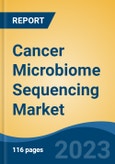Free Webex Call
The global cancer microbiome sequencing market is anticipated to observe impressive growth during the forecast period 2023-2027. The major factors, including growing occurrences of cancer and increasing emphasis on the microbiome’s potential in the field of cancer, are fueling the growth of the market. Microbiomes are the community of microorganisms that grow or exist in an environment, such as saliva, skin layers, oral mucosa of the human body, and the gastrointestinal tract. Microbiome sequencing is a valuable tool that is used to study and analyze the microbes groups located in or out of the human body to have a better understanding of human microbes. The main aim of a microbiome research study is to understand the role and function of microbes in human health and disease. The other factors supporting the market’s growth are decreasing cost of sequencing, the rise in R&D activities, the exponential rise in the number of cancer cases worldwide, the increasing number of clinical trials, the rise in the development of novel diagnostic tools based on the microbiome for supporting physicians, increasing investments by biotechnology companies, rise in demand for microbiome sequencing services for diagnosis and early detection of the diseases, rise in world population, growing awareness of the use of microbiome sequencing technology, rise in the healthcare expenditure, rising interest of researchers in understanding the role of the microbiome in human health and disease, and immense potential for emerging submarkets.Speak directly to the analyst to clarify any post sales queries you may have.
10% Free customizationThis report comes with 10% free customization, enabling you to add data that meets your specific business needs.
The rising Prevalence of Cancer supports Market Growth.
Growing incidences of cancer, such as lung, cervical, breast, skin, throat, and others, are augmenting the growth of the market. According to WHO, in 2020, cancer is a major cause of death across the world, reporting approximately 10 million deaths, or about one in six deaths. The most common cancers are lung, colon and rectum, prostate cancers, and breast. There is a surge in the number of cases suffering from cancer caused due to consumption of alcohol, tobacco use, unhealthy eating choices, and sedentary lifestyle. Therefore, the need for cancer microbiome sequencing is rising, which in turn, bolsters the growth of the market. As per WHO, many cancers can be treated effectively if detected in an early stage.
Increasing Emphasis by Researchers on the Microbiome’s Potential and Rising Support from Biotechnology Companies.
The rising focus on the microbiome’s potential to diagnose and prevent various cancers is fueling the growth of the market. Various researchers are studying and researching the microbiome’s potential in the field of cancers. Researchers are being supported by biotech companies to unravel insights pertaining to the microbiome’s influence on cancer progression and manifestation. Furthermore, the development of cancer microbiome sequencing services and products has aided the research community in creating effective strategies for discovering novel cancer biomarkers allied with the microbiome, which could be used for the development of cancer microbiome sequencing products for clinical use.
Market Segmentation
The global cancer microbiome sequencing market is segmented into components, technology, application, end-user, and company. Based on components, the market is divided into kits & assays, software, and services. Based on technology, the market is divided into next-generation sequencing and polymerase chain reaction. Based on application, the market is divided into translational research and clinical diagnostics. Based on end-user, the market is divided into biotechnology & pharmaceutical companies, academic & research institutions, hospitals & clinics, and others. In terms of country, the United States is expected to be a lucrative market in the forecast period due to rising incidences of cancer and a rise in R&D activities in the country.Market Players
Illumina, Inc., Eurofins Scientific SE, QIAGEN NV, Thermo Fischer Scientific, Inc., Oxford Nanopore Technologies plc., OraSure Technologies, Inc., Pacific Biosciences of California, Inc., Psomagen, Inc, Prescient Medicine Holdings, Inc., and Micronoma Inc. are some of the leading companies operating in the market.Report Scope:
In this report, global cancer microbiome sequencing market has been segmented into the following categories, in addition to the industry trends, which have also been detailed below:Cancer Microbiome Sequencing Market, By component:
- Kits & Assays
- software
- Services
Cancer Microbiome Sequencing Market, By technology:
- Next-Generation Sequencing
- Polymerase Chain Reaction
Cancer Microbiome Sequencing Market, By application:
- Translational Research
- Clinical Diagnostics
Cancer Microbiome Sequencing Market, By End User:
- Biotechnology & Pharmaceutical Companies,
- Academic & Research Institutions
- Hospitals & Clinics
- Others
Cancer Microbiome Sequencing Market, By Region:
- North America
- United States
- Canada
- Mexico
- Asia-Pacific
- China
- India
- Japan
- Australia
- South Korea
- Europe & CIS
- Germany
- France
- United Kingdom
- Spain
- Italy
- South America
- Brazil
- Argentina
- Colombia
- Middle East & Africa
- South Africa
- Saudi Arabia
- UAE
- Turkey
- Egypt
Competitive Landscape
Company Profiles: Detailed analysis of the major companies present in Global Cancer Microbiome Sequencing Market
This product will be delivered within 1-3 business days.
Table of Contents
1. Product Overview2. Research Methodology3. Executive Summary4. Impact of COVID-19 on Global Cancer Microbiome Sequencing Market5. Voice of Customer13. Market Trends & Developments15. Strategic Recommendations
6. Global Cancer Microbiome Sequencing Market Outlook
7. North America Cancer Microbiome Sequencing Market Outlook
8. Europe Cancer Microbiome Sequencing Market Outlook
9. Asia-Pacific Cancer Microbiome Sequencing Market Outlook
10. South America Cancer Microbiome Sequencing Market Outlook
11. Middle East and Africa Cancer Microbiome Sequencing Market Outlook
12. Market Dynamics
14. Competitive Landscape
Companies Mentioned
- Illumina, Inc.
- Eurofins Scientific SE
- QIAGEN NV
- Thermo Fischer Scientific, Inc.
- Oxford Nanopore Technologies plc.
- OraSure Technologies, Inc.
- Pacific Biosciences of California, Inc.
- Psomagen, Inc
- Prescient Medicine Holdings, Inc.
- Micronoma Inc.








